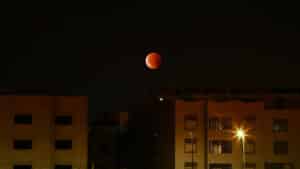The ninth chapter of the book of Daniel contains one of the most important prophecies in the Old Testament: it predicts when the Messiah would first appear in the world.
During the first year of Darius’ reign, Daniel discovered some interesting information while he was reading the sacred Jewish books, the Bible – or as much of it as had been written by that time. Daniel read that God declared through the prophet Jeremiah that the Babylonian exile would last 70 years.This information was of great value, especially for Daniel, because he was reading it in 538 BC. And since the Babylonian exile began in 605 BC, that meant it was soon coming to an end. So Daniel chose to come before God in prayer, repentance, and fasting. And God sent the angel Gabriel to tell him some very specific details about what would happen, and when the Messiah would come.
Daniel’s prayer has two main parts. The first part contains a confession regarding the sins of the people of Israel. The second part of Daniel’s prayer is a plea. Daniel urged God to forgive Israel for their sins, to return his people to the Land of Israel, and to reestablish Jerusalem and the temple to their former glory. These had, as Daniel recalled, both been destroyed by the Babylonians in 586 BC, and had been deserted since.
The thought that troubled Daniel was: If the Babylonian exile will really last 70 years, and these 70 years have almost ended, is God planning to postpone the end of the exile? Gabriel was about to put an end to Daniel’s embarrassment, by giving him a new revelation from God.
The words of the angel Gabriel appear in verses 24-27:
“Seventy weeks are decreed about your people and your holy city, to finish the transgression, to put an end to sin, and to atone for iniquity, to bring in everlasting righteousness, to seal both vision and prophet, and to anoint a most holy place. Know therefore and understand that from the going out of the word to restore and build Jerusalem to the coming of an anointed one, a prince, there shall be seven weeks. Then for sixty-two weeks it shall be built again with squares and moat, but in a troubled time.
And after the sixty-two weeks, an anointed one shall be cut off and shall have nothing. And the people of the prince who is to come shall destroy the city and the sanctuary. Its end shall come with a flood, and to the end there shall be war. Desolations are decreed. And he shall make a strong covenant with many for one week, and for half of the week he shall put an end to sacrifice and offering. And on the wing of abominations shall come one who makes desolate, until the decreed end is poured out on the desolator.”
Through the new revelation in these verses, God explains that Israel’s punishment will last at least another seventy weeks of years after the end of the Babylonian exile. In order to understand the prophecy properly, we need to understand a few parameters: First of all, this prophecy refers to Daniel’s people and to his holy city; meaning, the people of Israel and Jerusalem. Second, this prophecy refers to a timeframe of 490 years. Gabriel said that seventy weeks, which is seventy times seven (490) were sentenced on Israel and Jerusalem by God- that is to say, 490 years. Rashi and the Gaon of Vilna also interpreted this timeframe in a similar way.
In verse 25, we see the starting point of the 490 years. The angel Gabriel indicated that the starting point will be a decree to rebuild Jerusalem with “squares and moat”. Squares in the scriptures are what we refer to today as the “City Gates”- the protected squares inside the city gates, which were the center of city life, for which walls and gates were necessary. The word “moat” refers to a protective canal, which was part of the city’s defense system. In ancient times, it was customary to dig a deep canal around the city walls as a mean of defense. Therefore, the building of a moat or canal requires the building of walls and defense system. We can conclude from this, that the decree in verse 25 speaks about the fortification of Jerusalem as a pre-condition.
In the year 445 BC, Nehemiah heard that the walls of Jerusalem were still destroyed and he received a decree from King Artaxerxes I. Therefore, the starting point of the 490 years of the prophecy in Daniel 9 was March of 445 BC, according to the Gregorian calendar. In addition to that, Gabriel indicates the time in which the Messiah will come. He says that between the issuing of this decree to “the coming of an anointed one”, there will be 69 sevens of years, meaning 483 years. In other words, Gabriel sets a deadline for the coming of the Messiah. Within 483 years from 445 BC, the Messiah would arrive.
When we calculate the time periods based on the information given by Gabriel, we need to remember that a year consisted of 360 days in ancient times. Therefore, 483 years from the time of the decree by King Artaxerxes I in 445 BC, brings us directly to the year 32 AD. After that, in verse 26, Gabriel indicates that, “an anointed one shall be cut off.” The words “cut off” were used to describe a death penalty- the Messiah would be sentenced to a violent death. After that, Gabriel indicates that people “shall destroy the city and the sanctuary.” The city and the Temple were destined to be destroyed after the Messiah dies. And indeed, in the year 70 AD, the Romans destroyed both Jerusalem and the Temple.
In conclusion, according to the prophecy of Daniel chapter 9, the coming and death of the Messiah are calculated to occur in the year 32 AD. During Passover of 32 AD, that same Anointed One was killed in a violent death by crucifixion – the One about whom all the prophecies in the Old Testament testify regarding his Messiahship: Jesus.
But even if for a moment we ignore all the numbers given by the angel Gabriel, we can focus on the specific historical events described in the prophecy regarding the coming of the Messiah. Gabriel prophesied that Jerusalem would be rebuilt and later would be destroyed again. The Messiah was to come and to die in between these two events. Even without Gabriel’s calculation, the Messiah must come and die no later than 70 AD, when Jerusalem and the temple were destroyed by the Romans.
It is interesting to see that Rashi attributed verse 27 to “the days of the Messiah King.” (And he shall make a strong covenant with many for one week, and for half of the week he shall put an end to sacrifice and offering. And on the wing of abominations shall come one who makes desolate, until the decreed end is poured out on the desolator.”) But Rashi detached it completely from the rest of the verses in the chapter, and from the timeline that appears in them. Do you wonder why?
It was for the same reason that the Sages accused the prophet Daniel of being wrong in his calculations, of course: “Rabba said: Even Daniel was mistaken in this calculation” (Megilla 12a). This, so you will not know that Daniel was clearly pointing to the Messiah… to Jesus.
















